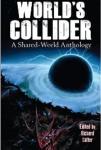
Richard Salter, ed.
Nightscape Press
$7.99 trade paperback, $2.99 digital edition
Review by Michael R. Collings
It used to be that nightmare tales concerning CERN’s Large Hadron Collider concentrated on the possibility/probability that scientific experimentation with subatomic particles might inadvertently create a black hole that would quickly expand; end all life as we know it; and engulf the planet, the solar system, the galaxy, and — worst-case scenario, of course — the entire universe … or universes, whichever was most applicable.
Now, thanks to Richard Salter’s remarkable shared-universe anthology, World’s Collider, we know that there is indeed something worse to contemplate: what if the accident does not create a black hole but instead opens a rift between our reality and somewhere-other. What if it does not mercifully annihilate all human life but rather creates an opening through which — in a Lovecraftian Great Old Ones fashion — something huge and terrible and indescribable struggles to emerge? What if its presence is adumbrated by multiple smaller shifts in reality, by creatures that, though smaller and ultimately mortal, are nonetheless themselves terrible and indescribable? What if it dooms survivors to decades of fear and terror and destruction, to dreams and visions that might or might not reflect reality … if reality even exists any more?
The tales in World’s Collider explore all of these and multiple other potentialities through the medium of eighteen inter-connected short stories. In this it differs from conventional shared-world anthologies, in which authors accept the premise of a particular landscape or environment — often based on another author’s fictions — then move off in their own directions to explore individual characters, themes, etc. An excellent example of this kind of story-telling occurs in Paul Genesse’s several volumes of The Crimson Pact (2011-2012) — each story takes as its base the cataclysmic battle between humans and demons in the first story of the first volume, but the separate stories themselves may or may not be linked.
World’s Collider goes beyond this level of interrelatedness to incorporate recurring characters and what is essentially a single narrative, although one at times as broken, fragmented, and distorted as the world in which it occurs. As each carefully structured and meticulously placed story progresses, readers become gradually aware that there is a direction, that seemingly minor events or characters in one story might return with increasing significance, that what appears phantasmagorical in one story (a train that runs on tracks made of bone, for example) is in fact a critical part of the ultimate resolution.
And there is a resolution. Nothing is explained, of course, because in the universe(s) of World’s Collider nothing is ultimately explicable. But some puzzles are resolved, some questions answered, some sense made out of the senseless … and, in much the manner of Reign of Fire, remnant humanity is allowed to begin again.
I’ve not mentioned any stories in particular, in part because each is strong in its own right and each contributes to the whole in a way unusual in anthologies. However, for reasons external to the novel/anthology, I would like to point out one as fascinating.
Trent Zelazny’s “Black Whispers” is an ideal example of how the Collision has effects far beyond Europe. The story takes place in the southwestern U.S. The central character — drunk and maudlin over the death of his wife several years before — discovers a peculiar structure in the middle of the desert. He sticks his hand into it. Nothing. He thrusts his face into it. Nothing. By the time he has returned to the local bar for another drink, however, his hand and face have begun itching … furiously. Accompanied by other bar-regulars, including a beautiful woman, he returns to the object where, through a seemingly innocuous action, things from ‘out there’ are invited in, with devastating consequences.

Trent Zelazny
Nightscape Press
$7.99 trade paperback, $2.99 digital
The story fascinates me for the same reason that Stephen King’s Desperation (1996) and Richard Bachman’s The Regulators fascinate me. In these two novels, King/Bachman explores two different but connected versions of reality, landscape and characterization, and horror. In fact, he uses the same menu of names in both, attaching them to wildly different characters. The books are clearly separate but in an eerie way conjoined, just as Zelazny’s “Black Whispers” and his self-standing novella Butterfly Potion are clearly separate but eerily conjoined. Both have drunks as central characters; both have visions of a lost wife that trigger and nourish binges; both begin in a bar surrounded by desert; both inflict physical and mental pain on the main character; and both conclude elliptically. One is dark because it explores the darkness of the human psyche obsessed with guilt and loss; the other is dark because it explores not only that darkness but the darkness of horror, of the unknown and the unknowable. It is as if Zelazny looked at the same character — or startlingly similar character — and envisioned one in a world essentially like ours and the other in a world fundamentally and catastrophically unlike ours.
In a sense, the two stories allow readers to explore not only the characters and their worlds but the imagination that results in either tragedy or horror.
Much more could be said about World’s Collider and Butterfly Potion, but I will end by noting that both are products of Nightscape Press, which recently published remarkable Peter N. Dudar’s A Requiem for Dead Flies. Three at-bats; three home-runs.
Highly recommended (all of them).








